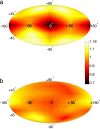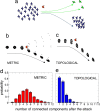Interaction ruling animal collective behavior depends on topological rather than metric distance: evidence from a field study
- PMID: 18227508
- PMCID: PMC2234121
- DOI: 10.1073/pnas.0711437105
Interaction ruling animal collective behavior depends on topological rather than metric distance: evidence from a field study
Abstract
Numerical models indicate that collective animal behavior may emerge from simple local rules of interaction among the individuals. However, very little is known about the nature of such interaction, so that models and theories mostly rely on aprioristic assumptions. By reconstructing the three-dimensional positions of individual birds in airborne flocks of a few thousand members, we show that the interaction does not depend on the metric distance, as most current models and theories assume, but rather on the topological distance. In fact, we discovered that each bird interacts on average with a fixed number of neighbors (six to seven), rather than with all neighbors within a fixed metric distance. We argue that a topological interaction is indispensable to maintain a flock's cohesion against the large density changes caused by external perturbations, typically predation. We support this hypothesis by numerical simulations, showing that a topological interaction grants significantly higher cohesion of the aggregation compared with a standard metric one.
Conflict of interest statement
The authors declare no conflict of interest.
Figures




References
-
- Parrish JK, Edelstein-Keshet L. Complexity, pattern, and evolutionary trade-offs in animal aggregation. Science. 1999;284:99–101. - PubMed
-
- Krause J, Ruxton GD. Living in Groups. Oxford: Oxford Univ Press; 2002.
-
- Emlen JT. Flocking behaviour in birds. The Auk. 1952;69:160–170.
-
- Pitcher TJ, Parrish JK. Behaviour of Teleost Fishes. In: Pitcher TJ, editor. London: Chapman and Hall; 1993.
-
- Gueron S, Levin SA, Rubenstein DI. The dynamics of herds: From individuals to aggregations. J Theor Biol. 1996;182:85–98.
Publication types
MeSH terms
LinkOut - more resources
Full Text Sources
Other Literature Sources

